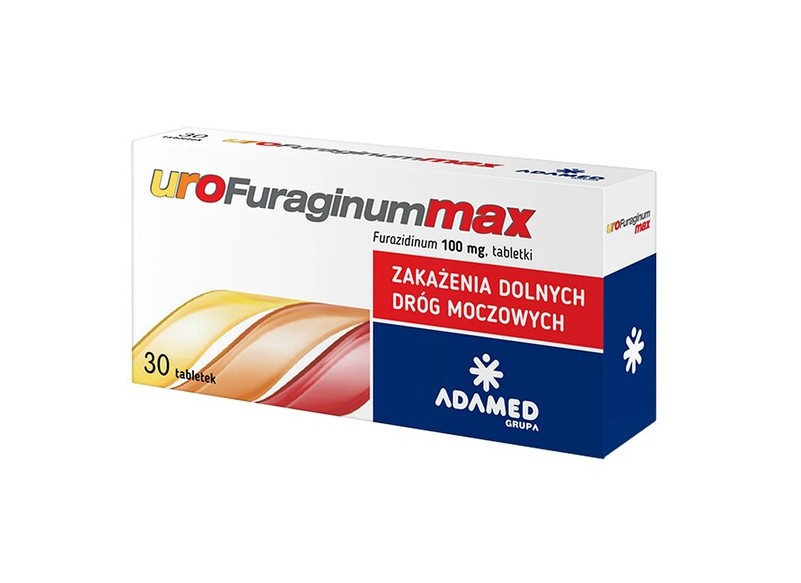UroFuraginum Max is a drug in the form of tablets for oral administration. The tablets contain the active ingredient furazidine, also called furagin, which is a derivative of nitrofuran.
Furazidine inhibits the growth of many bacteria that cause urinary tract infections.
Symptoms
Infections of the lower urinary tract.
Active substance: Furazidinum
Composition
The active substance is furazidine, also called furagin.
The other ingredients are: lactose monohydrate, silicified microcrystalline cellulose composed of: microcrystalline cellulose 98% and colloidal anhydrous silica 2%, magnesium stearate, colloidal anhydrous silica, sodium carboxymethyl starch type A.
Dosage and Use
- Adults and adolescents over 15 years of age: First day of use: 400 mg daily in 4 divided doses (1 tablet every 6 hours); next treatment days: 300 mg daily in 3 divided doses (1 tablet every 8 hours).
- Usually the drug is used for 7-8 days. If symptoms worsen or do not improve after 7-8 days, see your doctor.
- It must not be used in children and adolescents under 15 years of age.
- The tablet can be divided into equal doses.
- UroFuraginum Max should be administered with meals. At the same time, follow a diet rich in protein. The drug should be washed down with plenty of fluids.
Always take UroFuraginum Max exactly as described in the patient information leaflet or according to the doctor’s or pharmacist’s instructions. Check with your doctor or pharmacist if you are not sure.
Contraindications
- if you are allergic to furazidine or nitrofuran derivatives or any of the other ingredients of this medicine,
- in the first trimester of pregnancy,
- during term pregnancy (from 38 weeks) and childbirth, due to the risk of haemolytic anemia (anemia associated with the breakdown of red blood cells) in the newborn,
- in children and adolescents under 15 years of age,
- if you suffer from peripheral polyneuropathy, e.g. diabetic (peripheral nerve damage syndrome, which can be characterized by movement, sensory or other nervous system disorders),
- if the patient has a deficiency of the enzyme glucose-6-phosphate dehydrogenase (a disease associated with a genetically determined deficiency of an enzyme involved in the transformations taking place in red blood cells), because the drug may then cause haemolysis (damage to blood cells and anemia),
- if the patient is diagnosed with renal failure (oliguria, anuria) and laboratory tests show a creatinine clearance below 60 ml / min or an increased level of serum creatinine.
Contents
30 tablets
Storage method
15°C-25°C
Manufacturer
ADAMED
Warnings
Before taking UroFuraginum Max, talk to your doctor or pharmacist if you suffer from:
- kidney problems
- liver dysfunction
- nervous system disorders,
- anemia,
- electrolyte disturbances (changes in the concentration of ions in the blood), deficiency of B vitamins and folic acid,
- lung disease.
You should immediately stop using UroFuraginum Max and seek medical advice if:
- you develop symptoms such as fever, chills, cough, chest pain, shortness of breath, stop taking the medicine immediately and contact your doctor. These can be pulmonary reactions and sometimes occur during treatment with nitrofuran derivatives.
- you experience nervous system symptoms (tingling, numbness, feeling of running current). These could be signs of damage to the peripheral nerves (peripheral polyneuropathy), especially in people with diabetes, which in severe cases may be irreversible and may be life-threatening. Discontinue treatment immediately and contact your doctor.
- you develop symptoms of liver dysfunction (yellowing of the sclera of the eyes, skin and mucous membranes, dark urine, itchy skin, discoloration of the stools, abdominal pain, nausea, vomiting, constant tiredness, lack of appetite and weight loss). Jaundice can occur with short-term use of nitrofurans (up to two weeks). Chronic hepatitis (sometimes leading to liver necrosis – fatal cases have been reported) occurs in the course of long-term use of nitrofurans (usually over 6 months).
If you are taking the medicine for a long time, you may need a blood test to check the number of white blood cells and the function of your kidneys and liver.
Effect on laboratory tests: The drug may cause false-positive results of glucose tests in urine. Before submitting a urine sample for such examination, inform the medical staff that you are taking UroFuraginum Max.
Each 100 mg tablet contains 123 mg of lactose monohydrate. If you have been diagnosed with an intolerance to some sugars, consult your
doctor before taking the drug.
This medicine contains less than 1 mmol (23 mg) sodium per tablet, that is to say essentially ‘sodium-free’.
During pregnancy and breastfeeding
- If you are pregnant or breastfeeding, think you may be pregnant or are planning to have a baby, ask your doctor or pharmacist for advice before taking this medicine.
- UroFuraginum Max should not be used in the first trimester of pregnancy or in women in term pregnancy (from 38 weeks) and during childbirth, because furazidine may cause haemolytic anemia in the newborn. Particular caution should be exercised when used in the last three months of pregnancy (third trimester).
- Due to the excretion of furagin in human milk, the drug should not be used during breastfeeding.
Driving vehicles
There are no data on the effect of furaginum on the ability to drive and use machines. However, some patients may experience dizziness, somnolence, and visual disturbances which may affect the ability to drive and use machines.
Interactions with other drugs
Tell your doctor or pharmacist if you are taking or have recently taken any other medicines, and about any medicines you plan to take.
- Nitrofurans (which include furazidine) should not be combined with chloramphenicol, rystomicin, levomycetin, sulfanilamides (antibacterial drugs) as it may inhibit the haematopoietic system.
- Nalidixic acid and other quinolone derivatives should not be used simultaneously with furagin, as their antagonism (opposite effect) is usually observed.
- Aminoglycoside antibiotics and tetracyclines administered together with furazidine increase its antibacterial effect.
- Uricosuric drugs such as probenecid (in high doses) and sulfinpyrazone reduce tubular secretion of nitrofuran derivatives and may cause accumulation of furazidine in the body, increasing its toxicity and reducing the effectiveness of the treatment.
- Simultaneous administration of alkalizing drugs containing magnesium trisilicate inhibits furazidine absorption and reduces antibacterial activity.
- Atropine slows down the absorption of furagin, but the overall amount of active substance absorbed remains the same.
- Antacids inhibit the absorption of furazidine.
- Simultaneous intake of B vitamins increases the absorption of nitrofuran derivatives.
Side effects
Like all medicines, UroFuraginum Max may cause side effects, although not everybody gets them.
Among the adverse reactions observed during clinical trials, probably related to the use of the drug, the most common were nausea (8%), headache (6%) and excessive gas (1.5%).
The remaining symptoms listed below occurred in up to 1% of patients.
Stop taking this medicine immediately and tell your doctor or go to the nearest hospital if you experience:
- allergic reactions: rash, itching, hives, anaphylactic reactions (sudden local or systemic allergic reactions, including life-threatening anaphylactic shock), angioedema (severe allergic reaction – sudden swelling of the face, limbs or joints without itching or pain). Swelling of the head and neck may cause difficulty in swallowing and breathing;
- severe skin reactions (exfoliative dermatitis, erythema multiforme – reddish blue spots on the skin and / or mucous membranes, sometimes with blisters, fever and joint pain, Stevens-Johnson syndrome – occurrence of blisters on the skin and / or mucous membranes that after rupturing, they form painful wounds, often fever, pain in muscles and joints occur simultaneously);
- acute, subacute and chronic hypersensitivity reactions to nitrofuran derivatives. Chronic reactions occurred in patients taking the drug for more than 6 months. Chronic pulmonary reactions (including pulmonary fibrosis and disseminated interstitial pneumonia) may occur especially in the elderly. Acute respiratory hypersensitivity reactions presented as fever, chills, cough, chest pain, pleural effusion. They usually disappeared quickly or very quickly after drug discontinuation. In the case of chronic reactions, the severity of symptoms and their reversibility after discontinuation of drug administration depends on the duration of treatment continuation after the appearance of the first adverse symptoms. It is crucial to recognize the side effect as soon as possible and stop the medication.
- pseudomembranous enteritis (a severe disease of the small or large intestine with symptoms such as diarrhea, headache and fever);
- tingling, numbness, feeling of running currents as a result of peripheral neuropathy (damage to peripheral nerves), also acute or irreversible (especially predisposed to its occurrence: renal failure, anemia, diabetes, electrolyte disturbances, vitamin B deficiency);
- liver dysfunction, symptoms of drug-induced hepatitis, cholestatic jaundice (caused by an obstruction in the drainage of bile), necrosis of the liver parenchyma.
In addition, the following side effects may occur:
- cyanosis due to methaemoglobinaemia (the blue color of the skin with a chocolate-brown shade). In people with a deficiency of glucose-6-phosphate dehydrogenase, the use of furagin may lead to megaloblastic anemia (resulting from vitamin B12 or folic acid deficiency) or haemolytic anemia (resulting from the rapid breakdown of red blood cells),
- dizziness, sleepiness, visual disturbances
- constipation, diarrhea, dyspeptic symptoms (chronic epigastric pain),
- abdominal pain, vomiting,
- inflammation of the salivary glands, inflammation of the pancreas
- alopecia, exfoliative dermatitis,
- fever, chills, malaise,
- infections with microorganisms resistant to nitrofuran derivatives, most often with sticks of the genus Pseudomonas or fungi of the genus Candida.
The following have also been reported in patients taking furazidine:
- muscle cramps, muscle pain.




